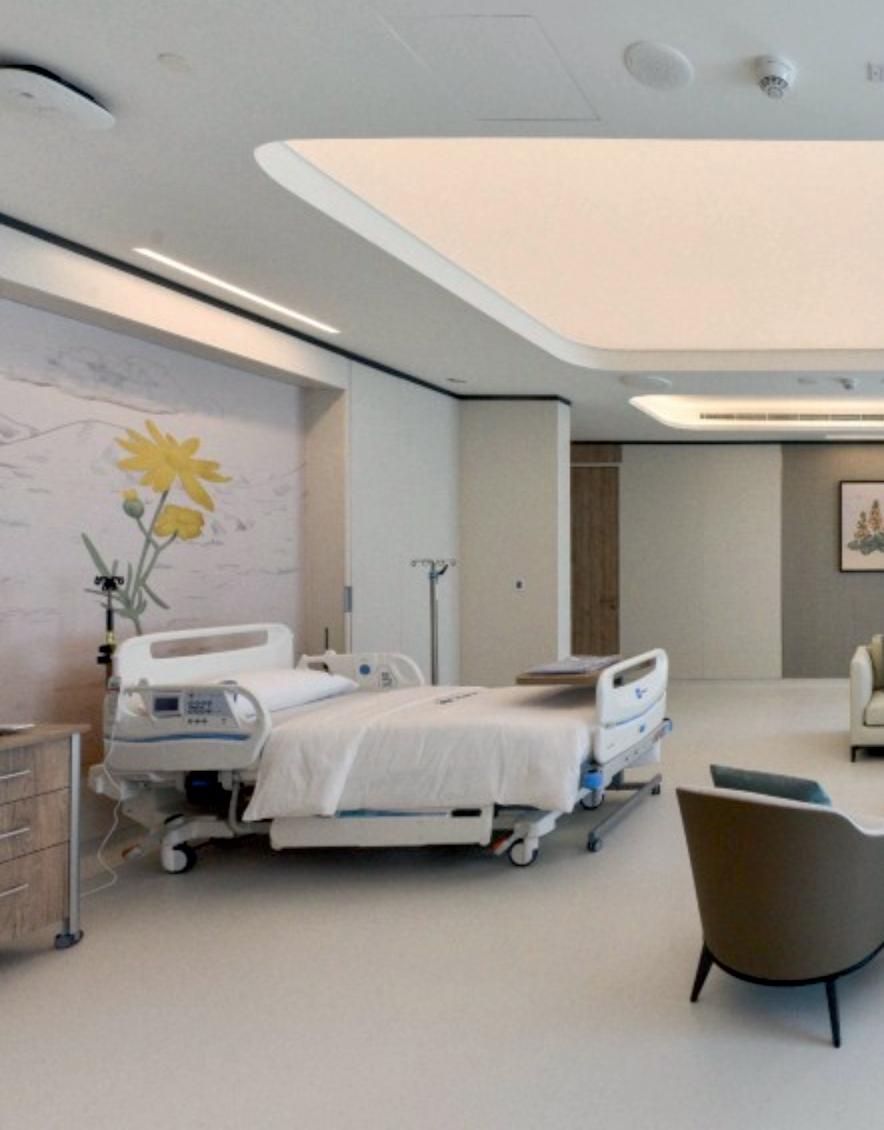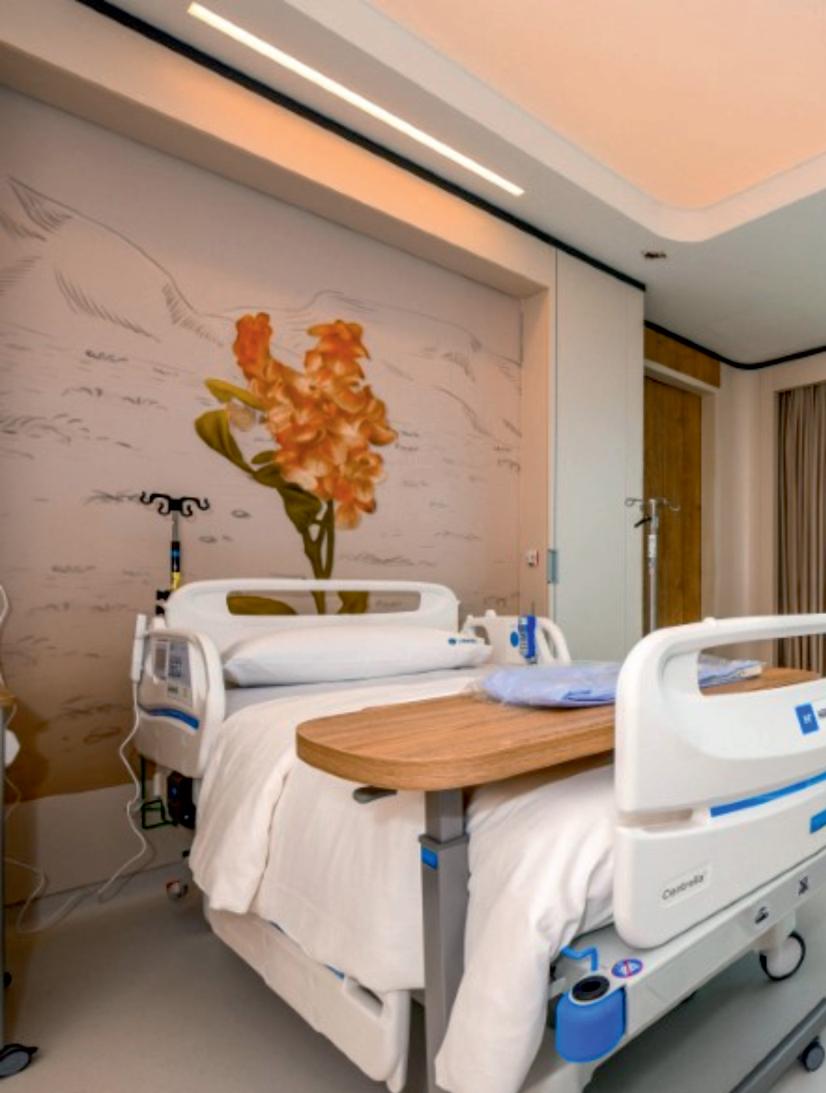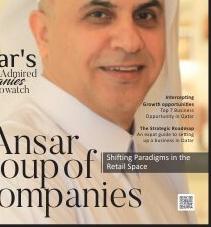






Successful CEOs are those who have the ability to inspire and motivate others, to build strong teams, and to lead by example.
- Cyril Ramaphosa






Patient-centeredcarehasneverbeenmorecrucialinthenew,changinglandscapeofhealthcare.Going
into2025,therewillbeawaveofnewleaderswhobelieveinempathy,individualizedneeds,and holisticapproachestowardcare.Thesearetheleadersoftodaywhowilldrivethistransformationinto howhealthsystemsinteractwiththeirpatients,therebymakingcareindividualized,accessible,andpersoncentered.
Patient-centeredcareisnotjustabouttreatingillness;it’saboutunderstandingthepatientasawholeand acknowledgingtheirpreferences,values,anduniqueneeds.Theseleadersareintegratingtechnology,datadrivensolutions,andcompassionatepracticestocreatehealthcareenvironmentswherepatientsfeelheard, respected,andempoweredintheircarejourneys.Theyareleadinginitiativesthatenhancethepatient experience,improveoutcomes,andensurethatcareisbotheffectiveandempathetic.
Fromredesigninghealthcaredeliverysystemstoadvocatingforpoliciesthatprioritizepatients’voices,these leadersaremakingaprofoundimpact.Theirinnovativeapproachesareimprovingpatientsatisfaction, streamliningcarecoordination,and,ultimately,transforminghowpatientsexperiencehealthcare.
Aswehighlighttheseexceptionalindividuals,wecelebratetheircontributionstoafuturewherepatientcenteredcareisnotjustagoalbutthestandard.Theircommitmenttoinnovation,compassion,andinclusivity ishelpingtosetnewbenchmarksinhealthcare,andtheirinfluencewillundoubtedlyshapetheindustryfor yearstocome.
Wearehonoredtosharethestoriesoftheseimpactfulleaderswhoseworkiscreatingamorecompassionate, patient-firsthealthcaresystemin2025andbeyond.
-AlayaBrown













F E A T U R I N G
06. Adrianna Sperkacz Balancing Technological Advancements with the Need for Human Connection in Care
A R T I C L E S
16. 20.
Why Does Patient Engagement Matter in Achieving Successful Health Outcomes?
Why is Multidisciplinary Teamwork Important in Delivering Patient-Centered Care?
Balancing Technological Advancements with the Need for Human Connection in Care

‘ ‘
Adrianna encourages leaders to learn from pa�ents, who provide invaluable insights.






aveyoueverthoughtaboutopeninguptoa
Hhealthcareprovideraboutwhattrulymattersto youorwhatyou'regoingthrough?Making patientsfeelheard,respected,andempoweredissomething thatmanymedicalpractitionerssincerelywishtodo.
Agrowingmovementtoimprovepatientexperiencesexists atthecenteroftechnologicaladvancementandcompassion. Healthcareexpertsarepromotingamorecomprehensive approachtocarethatraisesthebarfortreatmentand redefineswhatitmeanstobegenuinelypatient-centered.
HereisAdriannaSperkacz,whoseworkhighlightsthe valueofhearingpatients'talesandcreatinganatmosphere whereeachperson'svoiceisheardandtheirexperience counts.InherroleasGroupDirectorofPatient ExperienceatApexHealth,sheencouragesstafftolook beyondclinicalcriteriawhilehighlightingthevalueof emotionalintelligenceindeliveringtreatmentandengaging withpatientsaswholeindividuals.
Sheunderstandsthatthetruepurposeofhealthcareisto healboththebodyandthespirit-upliftingthehuman experiencealongsidecuringtheillness.Shepromotesa strategythatplacesahighvalueonempathy,respectand understandingthroughasincererelationshipbetween patients,lovedones,doctorsandstaff.Shehasaclear visionforthehealthcaresystem:oneinwhicheachpatient feelsheardandrespected,resultinginbettersatisfaction andqualityoutcomes.
Adriannabringsthisvisiontolifethroughherinnovative effortsandhuman-driveninitiatives.Drivenbyherbeliefin thepowerofhumanconnection,shehasimplemented creativestrategiestoenhancepatientexperiencesatevery touchpointalongtheirjourney.Collaborationandtrustbuildingarehallmarksofherleadershipapproach,which createsanatmospherewherepatientsandemployees flourish.
Underherguidance,sheimplementedpoint-of-care feedbackchannelsthatrevolutionizedcaredeliveryby integratingreal-timepatientfeedbackintodailyoperations. Thisinitiativenotonlyimprovedsatisfactionscoresbut alsofosteredacultureofreadiness,proactiveservice recovery,andcompassionwithinthehealthcaresystem.



Adriannahasbeenprofoundlyinfluencedbyherbeliefin thesignificanceofhumanconnectioninhealthcare.From anearlyage,sherecognizedthateffectivecaretranscends merelytreatingillnesses;itinvolvesunderstandingpatients aswholeindividualswithuniqueemotionsandstories.This philosophyhasbeenpivotalinshapingherleadershipstyle, whichemphasizescompassion,empathy,andinnovation.
Inherrole,Adriannaisdedicatedtocreatingan environmentwherepatientsfeelheard,valued,and empowered.Sheprioritizestheestablishmentofgenuine connectionsamonghealthcarestaffandpatientsalike.
Forher,leadershipisnotaboutexertingauthoritybutabout cultivatingtrustandcollaborationthroughasharedmission. Adrianna’sapproachcombinescompassionwithaforwardthinkingmindset,aimingtocreatesystemsthatareboth efficientanddeeplyhumaneintheiroperations.
AdriannaledatransformativeinitiativeatApexHealth, implementingfeedbackchannelsaimedtoenhancingthe patientexperienceacrossallpointsofthepatientjourney. Thisinitiativefocusedonensuringthateverypatient interactionwascharacterizedbyempathyandrespect.By promotingseamlesscommunicationacrossdepartments,the projectprioritizedpatientneedsandestablishedtargeted alertstoguidestaffactions.
Akeycomponentofthisinitiativewastheintegrationof real-timepatientfeedbackintodailyoperationsthroughAIdriventools.Thisallowedtheteamtoaddressconcerns promptlyandcelebratepositiveexperiencesimmediately
Additionally,comprehensivecompassionatecaretraining wasprovidedtostaff,equippingthemtobetterunderstand patients'emotionalneeds.Asaresult,patientsatisfaction scoresimproved,trustinthehealthcaresystemincreased andstaffengagementgrew-creatingaculturewhereevery teammemberfeltconnectedtothemissionofdelivering personalizedandcompassionatecare.
Adriannaemphasizestheimportanceofengagingstaffto cultivateacultureofpatient-centeredcarewithinher
organization.Shebelievesthataligningeveryonearounda sharedpurposeiscrucialforhumanizingthecareprocess. Byempoweringhealthcareprofessionalsandensuringthey feelvalued,Adriannaenablesthemtoextendthat compassiontopatients.

‘ ‘ and resilience.
Toengagestaffeffectively,sheutilizesstorytellingand sharedexperiences.Regularinteractiveworkshopsand scenario-basedtraininghelpstaffempathizewithpatients byfocusingontheemotionalaspectsofcare.
Additionally,sheconductsopenforumsandleadership rounds,encouragingstaffatalllevelstovoicetheir opinionsandsharebarrierstheyencounterindelivering exceptionalpatientcare.Thistwo-waycommunication fostersasenseofinvolvementandownershipamong employees.Whenstafffeelgenuinelyengagedand connectedtoalargermission,theybecomepassionate advocatesforprovidingcompassionatecaretopatients.
Adriannahasfacedsignificantchallengesinimplementing patient-centeredpractices,particularlyresistancetochange withinestablishedhealthcaresystems.Inahigh-pressure environment,thefocusonclinicalandoperationalmetrics canovershadowtheessentialhumanelementofcare.
Toaddressthis,sheintegratedpatient-centeredpractices intothehospital'soperationalframework,makingthema corefunctionratherthananadditionaltask.Thisintegration requiredretrainingstaffandrethinkingworkflowstoallow automationofmanualprocessesandmoretimefor meaningfulpatientinteractions.
Adriannaemphasizedthatthesechangesaimednotonlyto improvepatientsatisfactionscoresbutalsotobuildtrust andfosterlong-termrelationshipswithpatients.Her
approachcombinedpersistence,education,and leadingbyexample.Bydemonstratingtangible outcomessuchasimprovedpatientresultsand higherstaffmoraleshesuccessfullyillustratedthat patient-centeredcareissustainableandbeneficial forallstakeholdersinvolved.
Adriannahighlightskeyqualitiesessentialfor leadersinpatient-centeredcare:compassion, resilience,adaptability,andvision.Compassion formsthefoundation,recognizingthatmeaningful healthcarestemsfromgenuinecareforboth patientsandstaff.Resilienceisindispensablefor navigatingchallenges,whetherduringcrisesorin overcomingresistancetochange.
Sheexemplifiesthesequalitiesbybuildingstrong connectionswithpatientsandstaffalike.Leading withempathy,sheaddressestheobstaclesfacedby bothgroupsandtakesdecisiveactiontoremove barrierstocompassionatecare.Heradaptability shinesthroughherembraceofnewtechnologies andevolvingpatientexpectations,driving innovativesolutionslikeAIandreal-time feedback.
Visionremainsacornerstoneofherleadership,asshe consistentlysetsaclearcourseforadvancingpatientcenteredcare.Adriannaensuresthateveryteam memberunderstandstheirroleinachievingthisshared mission,fosteringaculturedeeplycommittedto deliveringcompassionate,high-qualitycareatevery touchpoint.



Adriannameasuresthesuccessofpatient-centered initiativesthroughacombinationofqualitativeand





‘Adrianna priori�zes staying updated on the latest trends and research in pa�ent-centered care to drive con�nuous improvement.
‘


quantitativedata.Centraltoherevaluationis patientfeedback,gatheredviareal-timetools, surveys,andtestimonials,whichrevealhow patientsperceivetheircareexperience.Onthe quantitativeside,shetrackskeyperformance indicatorssuchaspatientsatisfactionscores, correlation,andcomplaintresolutionmeasures toassesstheimpactofimplementedchanges. However,Adriannabelievesthatsuccess extendsbeyondmetrics;itencompasses culturalshiftswithintheorganization.She observesstaffinteractionswithpatientsand eachother,notingimprovementsin compassionandcollaboration.When departmentstransitionfromtransactionalto relationalapproaches,sherecognizesthat meaningfulprogresshasbeenmadeinfosteringa environmentthatisholisticandhumancentered.
CompassionisthecornerstoneofAdrianna's leadershipapproach,influencingherdecisionsand interactionswithbothpatientsandstaff.She believesincreatinganenvironmentwhere compassionisfundamentalandpracticeddaily.
Adriannafostersthisqualitybyleadingwith vulnerabilityandempathyandsharingimpactful patientstoriestohighlighttheimportanceof emotionalintelligenceinhealthcare.Through regulartrainingandworkshops,sheequipsherteam withtheskillsneededtoapproacheverypatient interactionwithempathy.
Additionally,shemodelscompassionateleadership bysupportingherstaffandensuringtheyfeel valued.Thisnurturingenvironmentenables

healthcareprofessionalstoextendthesamecompassionto theirpatients,transformingcareintoameaningfulpractice thatenhancesexperiencesforeveryoneinvolved.

‘
‘ In her role, Adrianna is dedicated to crea�ng an environment where pa�ents feel heard, valued, and empowered.
Adriannaprioritizesensuringthatpatientsandtheirfamilies areintegraltodecision-makingprocesses.Shebelievesthat enhancingpatient-centeredcarebeginswithinvitingtheir input.Tofacilitatethis,Adriannaestablishedpatient advisoryboardsanddailyrounding,allowingpatientsand familiestoshareexperiencesandinfluencehospital policies.

Regularfeedbackisgatheredthroughsurveys,focus groups,andone-on-onediscussions,withacommitmentto actingonthisinformationtoidentifyareasfor improvement.Transparencyiskey;shekeepspatients informedaboutchangesmadebasedontheirfeedback, reinforcingthevalueoftheirvoices.Byfosteringthis inclusiveenvironment,Adriannaensuresthatpatient


perspectivesremaincentraltothehospital'sdecisionmakingprocesses.
Adriannaemphasizestheimportanceofcollaboration acrossdepartmentstoachievepatient-centeredcare.She fostersacultureofopencommunicationandsharedpurpose throughregularcross-departmentalmeetings,allowing teamstoaligntheirgoalsandunderstandtheirimpacton patientexperiences.
Interdisciplinaryroundsarealsoutilized,bringingtogether variousdepartmentstodiscusspatientcasesandidentify opportunitiesforintegratedcare.
Additionally,Adriannaleveragestechnologyby implementingshareddigitalplatformsthatprovideall departmentsaccesstothepatientfeedback.This comprehensiveapproachensuresthateveryteamworks collaborativelytowardsdeliveringcompassionateand comprehensivecaretailoredtoeachpatient'suniqueneeds.
Adriannaprioritizesstayingupdatedonthelatesttrendsand researchinpatient-centeredcaretodrivecontinuous improvement.Sheregularlyattendsandspeaksinindustry conferences,participatesinwebinars,andengageswith professionalnetworksfocusedonhealthcarequalityand experience.
Adriannaemphasizescontinuouslearningforherselfand herteamthrougharobusttrainingprogramthat incorporatesevidence-basedpracticesandconnectionto purpose.Whenshediscoversnewapproaches,sheevaluates andsharestheirpotentialforenhancingcaredelivery
Additionally,shebenchmarksperformanceagainsttop-tier healthcareinstitutionstoidentifygapsandimplement necessarychanges,ensuringherorganizationremainsatthe forefrontofpatient-centeredcare.
Adriannaadvisesemerginghealthcareleaderstoleadwith purpose,compassion,andresilience.Sheemphasizesthe importanceofstayinggroundedinone’smissionto navigatethedemandinghealthcarelandscapeeffectively. Developingemotionalintelligenceandfosteringstrong relationshipsarecrucial,ashealthcareisfundamentally abouthumanconnection.
Adriannaencouragesleaderstolearnfrompatients,who provideinvaluableinsights.Shealsohighlightstheneedfor innovation,urgingleaderstoembracecreativityinmeeting evolvingpatientneeds.Bystayingcuriousandopento change,aspiringleaderscansignificantlyimpactthe healthcaresectorandenhancethequalityofcareprovided topatients.
Patientengagementisoneofthecriticalelementsin
modernhealthcare,whichgreatlyaffectshealth outcomes.Patientengagementcanbedefinedasan activerolepatientsplayintheircarejourneyfrom preventionandtreatmenttorecovery.Theabilityofan individualtobeempoweredincontrollinghishealth situationwillmakepatientengagementasignificant determinantinattainingoptimalhealthresultsthrough cooperationbetweenthepatientsandhealthcareproviders.
Engagedpatientshavebettercompliancetotreatment interventions.Better-managedsymptomsleadtoalesser potentialforcomplications.Thisresultsinthebetterhealth outcomeassociatedwithlesserrisksofreadmissionsinto hospitalsandimprovedqualityoflivesasawhole.When oneisactivelyincare,moreinformationiseasilyconveyed tohimfromtheclinician.Thisopendiscussionensuresthat moreappropriateandeffectivetreatmentasprovidersgeta chancetousepatient-specifictailoredtreatmentsaccording toapatient'sindividualneeds.
Furthermore,patientengagementisincreasinglybecoming anintegralpartofvalue-basedcare.Thisispremisedonthe outcomeforpatientsandqualityofcareovervolume.The needforpatientengagementbecomesevenmoreimperative ashealthcaresystemsmovetowardthismodel.A participatorypatientwouldlikelyleadtoabetteroutcome forhealth,besidesreducingthetotalhealthcarecost becauseofalackofinappropriateinterventionsand hospitalizations.





Effectivecommunicationisacriticalfactorinthe promotionofpatientengagement.Encouragingpatientsto askquestionsandexpressconcernsfostersanenvironment oftrustandcollaborationwithhealthcareproviders. Patientswhofeelheardaremorelikelytobeactive participantsintheirtreatmentdecisions.Thispartnership fostersbetterunderstandingbetweenbothparties,whichin turnenhancesadherencetoprescribedtreatmentsand lifestylechanges.
Technologyintegrationhasfurtherenabledthefacilitation ofpatientengagement.Patientscanaccesstheirhealth information,seekappointmentsandconversewith providersonline.Thetoolsallowpatientstoengageactively inthemanagementofhealth.Theoutcomeofsuchsupport fromtechnologygoesbeyondpromotingtheaspectof engagementbutalsohasalargerimpactonthepatient experience.
Theactivationofthepatientisanessentialpartof engagement.Itisanindividual'sknowledge,skills,and confidenceinmanagingtheirhealth.Themoreactivateda patientis,themoreinvolvedheorsheisinhealthcare decisionsandtreatmentadherence.Healthcareproviders cansupportactivationthrougheducationalresourcesthat informpatientsabouttheirconditionsandtreatment options.
Withthissettinginanorganizationthatwillfoster activationamongpatients,therewilllikelybeincreased involvementofthepeople.Thismaycomeaboutin techniquessuchaspersonalizededucationaswellas motivationinterviewingtechniqueswhileengaginginsome decision-makingtechniqueswiththeclients.Aclientwho understandsthecauseofhisdistressandiscourageousto takeholdofthecasewillbeabletoparticipatemuchwith hisserviceteam.
Patientengagementnotonlybenefitstheindividual'shealth outcomesbutalsothehealthcaresystematlarge.Patients whoareengagedcanimprovecarequalitybecausethey provideneededfeedbacktohealthcareprovidersontheir needs.Theconversefeedbackloopallowscontinuous improvementinservicedeliveryandsatisfaction.
Patientengagementwoulddecreasehealthcarecosts.When integratedtopatientcare,lessercomplicationwillshowin
thosepatientsregardingeconomicalinterferenceor hospitalizationduetopoorcontrol,sopossiblesavingof lotsofresourcescanbedoneforthepatientandtheir respectivehealthsystems.
Moreover,involvedpatientsaremorelikelytobesatisfied withtheircareexperiences.Theyfeelmoreincontrolwhen theyhaveasayinthedecisionsmaderegardingtheir treatmentandunderstandthereasonsbehindthem.This satisfactionisimportantforbuildinglong-term relationshipsbetweenpatientsandproviders,whichinturn enhancestheeffectivenessofcaredelivery
Thereareobviousadvantagesofpatientengagement,but therearealsoseveralbarriersthatmaypreventits implementation.Theseinclude,butarenotlimitedto, limitedhealthliteracyamongpatients,timeconstraints duringconsultations,anddifferingattitudesofhealthcare providersabouttheimportanceofengagement.All stakeholdersinvolvedinhealthcaredeliverymustmake concertedeffortstoovercomethesechallenges.
Healthcareprovidersshouldbetrainedontheskillsof effectivecommunicationthatengage.Also,thereisaneed tohaveeducationmaterialsavailabletopatients,targeting differentliteracylevels,inordertoequipthepatientwith informationtotakeanactiveroleintheircare.
Conclusion
Ending,guidelinesarethereregardingpatientengagement intheachievementofsuccessfulhealthoutcomesintoday's healthcarelandscape.Healthcareprovidersenhance communicationandimproveadherencetotreatmentplans throughactiveparticipationbythepatientsingeneral, overallprovidinghigherqualitycare.Value-basedcare necessitatesengagingthepatientsaspartnersinthejourney ofhealth.
Morerecentdevelopmentintechnologycanbeaccessedfor furthermeansofenhancingtheengagementofthepatient throughbetteraccesstoinformationandcommunication. Thehealthsystemwillbeassuredthatpatientsparticipate effectivelyinhealthmanagementbytheeliminationof obstaclesandencouragementofstrategiesthatencourage activationandparticipation.
Inthissetting,patientsandproviderscanbenefitthrough betteroutcomesandhighersatisfactionlevelsincreatinga healthierfutureforallthoseinvolvedinthejourneyof healthcare.



Multidisciplinaryteamworkisanessential
elementinprovidingpatient-centeredcarein themodernhealthcareenvironment.It involvesacollaborativeeffortofdifferenthealthcare professionals,eachbringinguniqueexpertiseand perspectivestothetable.Workingtogether,theseteams canbetteraddressthecomplexneedsofpatientsthanany singleprofessionalcouldontheirown.
Amultidisciplinaryteamwouldconsistofacombination ofhealthcareprofessionalsfromdiversefields,suchas medicine,nursing,pharmacy,socialwork,andtherapy, allcombiningtoformulateanintegratedcareplanfor eachpatient.Thiswouldbecrucialinanincreasingly complexenvironment,especiallywheretheaging populationandchronicdiseasesareontherise.Modern healthissuesareverymultifaceted,requiringvarious specialiststobringtheirknowledgeintoplayfor effectiveholisticcare.
Oneofthegreatestbenefitsofinterdisciplinary collaborationishowitinfluencespatientoutcomes. Healthcareprofessionalsareabletoformulatemore completeevaluationsandinterventionsbyworking together.Eachteammembercanconcentrateonhisor herspecificareaofpracticewhilealsothinkingaboutthe




greaterschemeofthingsthatispatient'shealth.This holisticmethodofapproachpreventserrorsanddetects problemssooner
Multidisciplinaryteamsoftenbringbetterhealthoutcomes forthepatients.Forinstance,theevidenceindicatesthat thosepatientstreatedinspecializedstrokeunitsbya collaborativeteamhavehigherchancesofregaining completerecoveryandmaintainingtheirindependencelong aftertreatment.Thediverseskillsetamongtheteam ensuresthattheapproachtowardsthecareofthepatientis well-rounded.
Thisensuressuccessfulteamworkthroughcommunication becauseitmeansopencommunicationchannelsarecreated inbetweenpeopletoshareallthatisdiscussedfreely.That canminimizemanymiscommunicationsaswellashelp limitpossibleerrorsfromthesecommunicationsintoproper patientcare.Patientsseemsatisfied,andthissometimes leadspatientstoexpresscomfortandassurancewithwhat wasdoneconcerningthetreatmentincare.
Clearcommunicationalsoaidsinstreamliningworkflows withinhealthcareorganizations.Intheeventthattasksare appropriatelydelegatedamongteammembers,thereisless duplicationofservices,savingtimeandresources.This efficiencybenefitsthehealthcareprovidersandimproves thepatientexperiencebyreducingwaittimesandaccessto necessarytreatments.
Professionaldevelopmentonthepartofhealth professionalsisfacilitatedbyinterdisciplinaryteams workingtogether Theyacquirenewknowledgeand understandingwithrespecttocareforthepatientsthrough interactionwitheachother.Amultidisciplinaryteam, therefore,helpsprovideeffectiveteamworkbecauseof mutualrespectandtrustinoneanother.
Thisfurtherallowshealthcareprofessionalstohavemore jobsatisfactionsincebeingpartofawell-functioningteam islikelytoprovidethat.Theresponsibilityfortheoutcome ofthepatientisdivided,whichlessensthepressure experiencedbyaloneprovider.Mostoftheteammembers feelenergizedduetotheinvolvementindecision-making, henceanamicableworkingenvironment.
Contemporaryhealthcarechallengesrequireamultiple approachtomanagepatients.Moreandmoretoday,patients showupwithissuesthatneedmanyspecialiststotreatthem incoordinatedefforts.Caseslikethesereallybenefitfrom beingmanagedbymulti-disciplinaryteamsbecausethey maybeabletoworkonthehealthissuebutcanalsolook intothesocialandpsychologicaldimensionsinvolved.
Forexample,forapatientdiagnosedwithdiabeteswho concurrentlyhasdepression,theinterdisciplinaryteam couldincludeanendocrinologist,mentalhealthproviders, dietitians,andsocialworkers.Theneachcouldimplement appropriateinterventionswithregardtothetotalwellbeing ofthepatient.Suchaholisticapproachbenefitsbothhealth outcomeandqualityoflifeofthepatient.
Patientsfeeltheircareistakencareofwhentheycansense thatcareisbeinghandledbyateamratherthanasingle individualwhohasbeenoperatingalone.Infact,duetothe collectiveapproachofthemultidisciplinaryteams,they facilitateshareddecision-making,whereinthepatientsarea partoftheplantobetreated.Inthisway,patientsfeel securedandbecomecooperativewithtreatmentprograms, whichmayleadtohealthieroutcomesintheend.
Inanutshell,multidisciplinaryteamsaresignificantinthe complexhealthcareenvironmenttodaytodeliverpatientcenteredcare.Bringingtogetherprofessionalsfromdiverse fieldswhoworkcollaborativelycanleadtoimproved patientoutcomesthroughthoroughassessmentsand integratedtreatmentplans.Improvedcommunication createstrustandsatisfactionamongpatientsaswellas encouragesprofessionaldevelopmentwithintheteam. healthcarecontinuestoevolve,embracingthiscollaborative approachwillbecrucialinaddressingthemultifaceted needsofpatientsandensuringhigh-qualitycareforall.


























